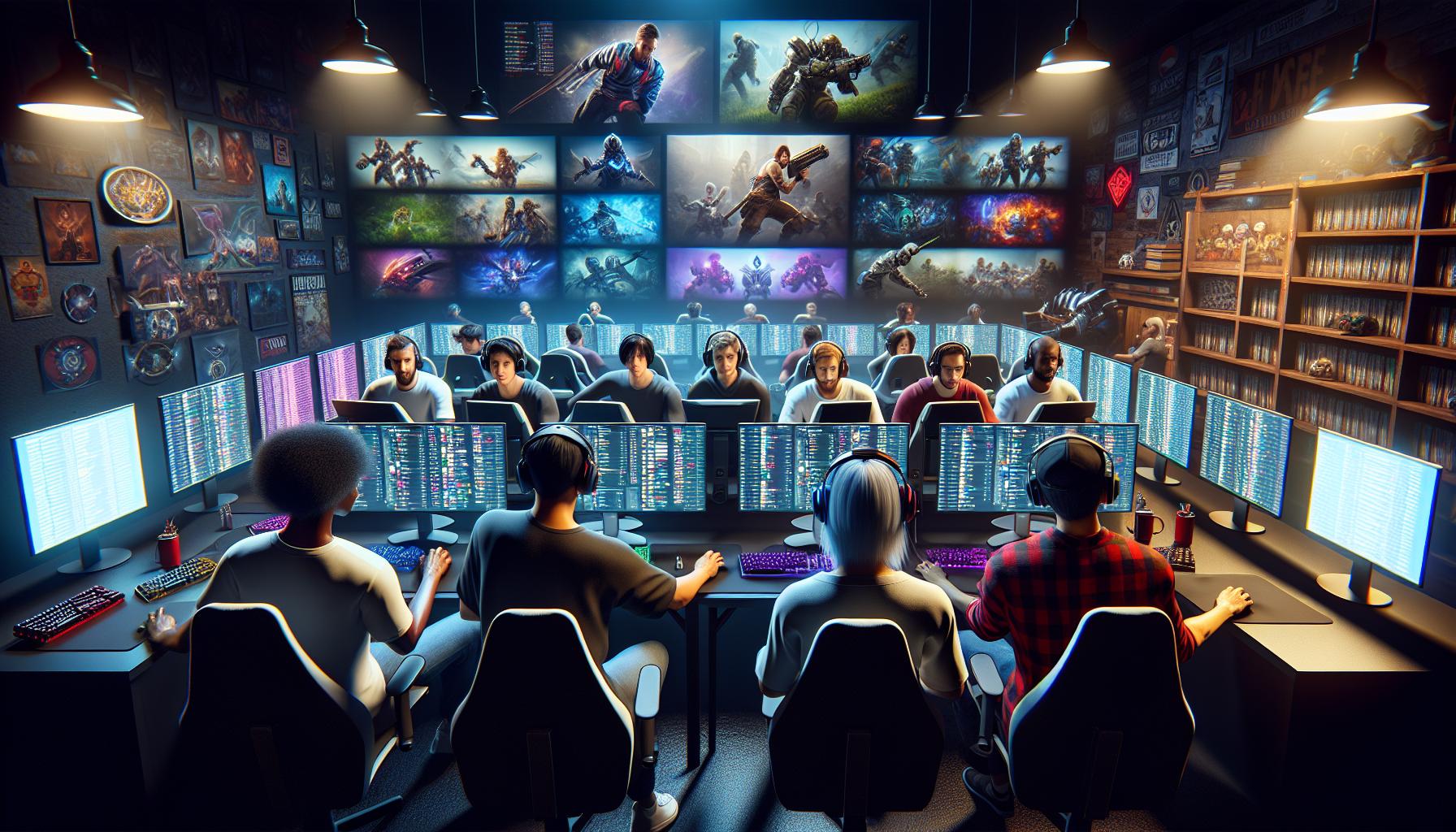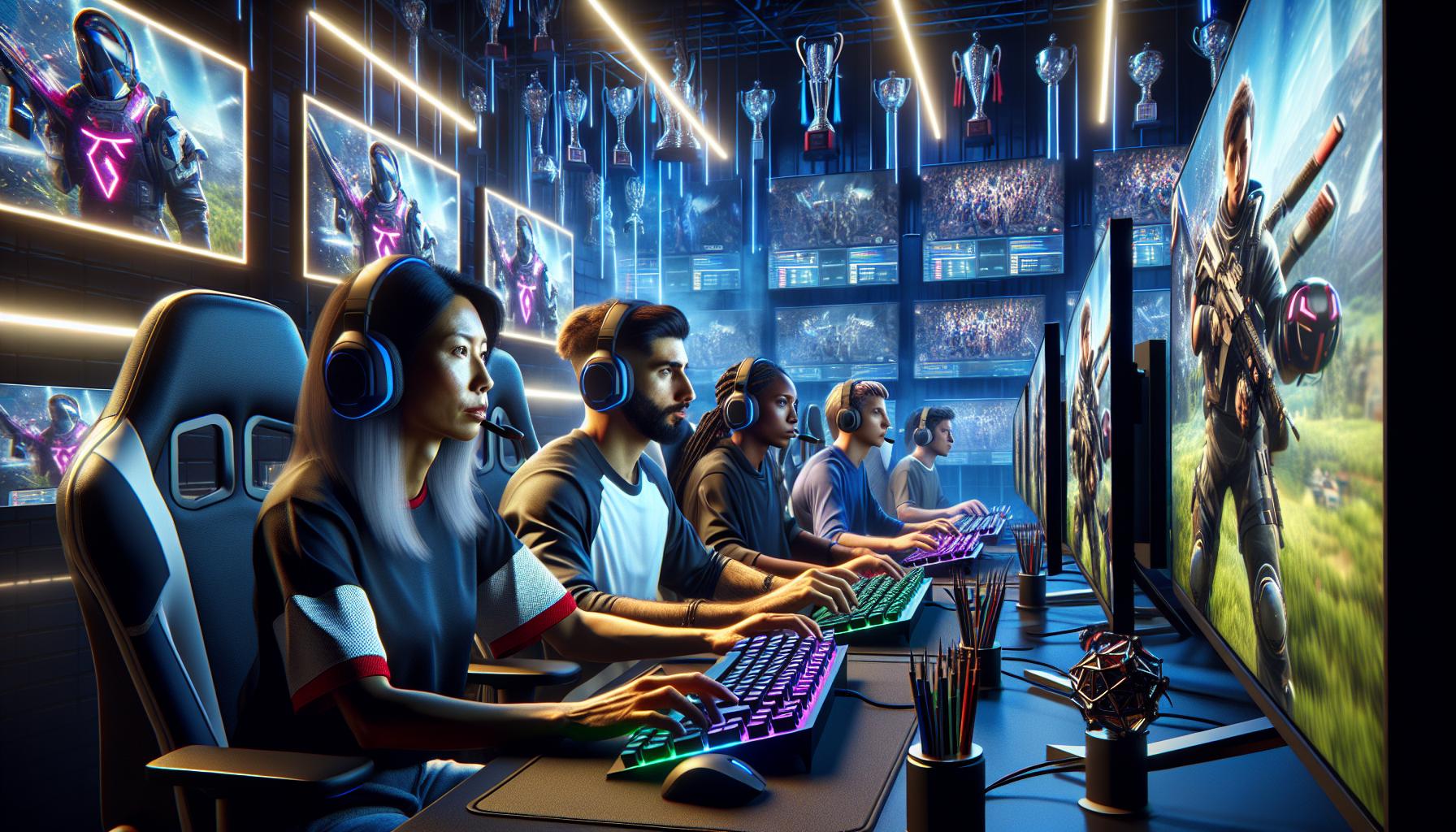As a dedicated esports enthusiast, I’ve witnessed the explosive growth of game streaming transform the competitive gaming landscape. What started as casual gameplay broadcasts has evolved into a billion-dollar industry where professional players and entertainers captivate millions of viewers daily.
I’ve spent countless hours analyzing how platforms like Twitch and YouTube Gaming have revolutionized the way we consume esports content. From major tournament broadcasts to individual pro player streams, these platforms offer unprecedented access to the world of competitive gaming. The beauty of esports streaming lies in its ability to combine high-level gameplay with real-time community interaction, creating an engaging experience that traditional sports can’t match.
Key Takeaways
- Esports streaming has evolved into a billion-dollar industry with 532 million global viewers in 2022, growing at 16.7% year-over-year
- Twitch dominates the market with 71% of total hours watched, followed by YouTube Gaming at 15.4%, offering features like high-quality streaming and interactive viewer engagement
- Top esports games for streaming include League of Legends (2.1B watch hours), VALORANT (1.14B hours), and Counter-Strike (1.3B hours)
- Successful streamers generate revenue through multiple channels including subscriptions, donations, advertising, sponsorships, and merchandise sales
- Essential streaming equipment includes professional microphones, cameras, capture cards, and a high-performance PC with specialized streaming software
- The future of esports streaming is being shaped by AI-enhanced broadcasting, cloud gaming integration, immersive viewing experiences, and blockchain technology
What Is Esports Streaming and Why It’s Growing
Esports streaming encompasses live broadcasts of competitive gaming events, professional matches, training sessions, tournaments. I’ve observed the transformation of streaming from basic screen captures to sophisticated multi-camera productions with professional commentary, real-time graphics overlays and interactive viewer elements. Just as customization plays a huge role in gaming—from personalized avatars to custom team jerseys—branding is equally crucial for streamers. Many successful gaming influencers enhance their brand identity with screen printed t-shirts, featuring unique logos and catchphrases that resonate with their audience.
The growth metrics of esports streaming showcase its rapid expansion:
| Metric | Value | Year |
|---|---|---|
| Global Viewers | 532 million | 2022 |
| Market Value | $1.38 billion | 2022 |
| Year-over-Year Growth | 16.7% | 2021-2022 |
| Peak Concurrent Viewers | 5.1 million | 2022 |
Five key factors drive this exponential growth:
- Enhanced internet infrastructure enables 4K quality streams at 60 frames per second
- Mobile streaming apps provide instant access across iOS Android devices
- Advanced monetization systems integrate subscriptions donations sponsored content
- AI-powered content moderation creates safer viewing environments
- Cross-platform integration connects viewers across Twitch YouTube Facebook Gaming
The streaming ecosystem includes multiple content categories:
- Professional tournaments featuring organized teams competing for prize pools
- Individual pro player streams showcasing practice sessions strategy discussions
- Educational content focusing on gameplay techniques meta analysis
- Entertainment streams combining gameplay with personality-driven content
- Behind-the-scenes coverage of esports teams events organizations
- Cloud-based streaming solutions reducing latency buffering issues
- Interactive overlay systems displaying real-time statistics player information
- Multi-language broadcast capabilities serving global audiences
- Virtual reality integration offering immersive viewing experiences
- Advanced chat moderation tools fostering engaged communities
Popular Esports Streaming Platforms

I’ve tracked numerous streaming platforms that host esports content, with each platform offering unique features for viewers and content creators. These platforms serve as the primary infrastructure for delivering competitive gaming content to millions of viewers worldwide.
Twitch and Its Dominance
Twitch leads the esports streaming market with 71% of total hours watched in 2022. The platform’s specialized features include Drops for in-game rewards, Channel Points for viewer engagement, and Extensions for interactive overlays. I’ve observed that Twitch’s exclusive partnerships with major tournaments like ESL Pro League attract 2.5 million concurrent viewers during peak events.
YouTube Gaming
YouTube Gaming captures 15.4% of all gaming livestream viewership through its seamless VOD integration. The platform’s key advantages include:
- Superior video quality up to 4K 60fps
- Automatic stream archiving
- Advanced DVR functionality for rewinding live broadcasts
- Integrated Super Chat monetization
- Cross-device synchronization
Other Major Platforms
Several alternative platforms have carved out specific niches in esports streaming:
| Platform | Market Share | Key Feature |
|---|---|---|
| Facebook Gaming | 7.9% | Built-in mobile streaming |
| Huya | 3.2% | Asia-focused content |
| AfreecaTV | 1.8% | Korean esports specialty |
| DLive | 0.7% | Blockchain-based rewards |
- Region-specific content focus
- Native language support
- Local payment systems
- Unique monetization methods
- Custom interactive features
Top Esports Games for Streaming

Based on my analysis of streaming metrics from 2022-2023, specific game titles consistently dominate esports streaming platforms with high viewer engagement rates. Here’s a detailed breakdown of the most successful streaming categories:
Battle Royale Games
VALORANT leads the battle royale streaming charts with 1.14 billion hours watched on Twitch in 2023. Apex Legends maintains its position as a top performer with 615 million viewing hours, featuring dynamic gameplay mechanics that attract both casual viewers and competitive enthusiasts. Fortnite continues to excel in the streaming space, generating 987 million watch hours through its engaging competitive tournaments and creator-focused content.
| Game | Annual Watch Hours | Peak Concurrent Viewers |
|---|---|---|
| VALORANT | 1.14B | 1.4M |
| Fortnite | 987M | 1.1M |
| Apex Legends | 615M | 632K |
MOBAs and Strategy Games
League of Legends dominates the MOBA category with 2.1 billion watch hours in 2023, featuring major tournaments like Worlds that peak at 5.1 million concurrent viewers. Dota 2 secures its position with 633 million annual watch hours, driven by The International tournament series. Counter-Strike maintains strong viewership with 1.3 billion hours watched, attracting audiences through intense competitive matches and strategic gameplay.
| Game | Annual Watch Hours | Major Tournament Peak Viewers |
|---|---|---|
| League of Legends | 2.1B | 5.1M |
| Counter-Strike | 1.3B | 2.4M |
| Dota 2 | 633M | 1.7M |
Making Money Through Esports Streaming

Esports streaming offers multiple revenue streams for content creators on platforms like Twitch and YouTube Gaming. I’ve identified the most effective monetization strategies and audience building techniques based on market data and successful streamer practices.
Monetization Methods
Esports streamers generate income through these primary channels:
- Subscriptions: Monthly viewer payments starting at $4.99 with platforms taking 30-50% of subscription revenue
- Donations: Direct viewer contributions through platform-specific systems like Bits on Twitch
- Advertising: Pre-roll ads generating $2-10 CPM rates based on viewer demographics
- Sponsorships: Brand deals ranging from $0.01-0.30 per viewer hour for established channels
- Merchandise: Custom apparel sales yielding 20-40% profit margins on each item
- Affiliate Marketing: Commission-based product promotions earning 5-15% per sale
- Tournament Winnings: Prize pools from competitive events ranging from $100 to $100,000+
- Consistent Schedule: Broadcasting 4-6 hours per day during peak viewing times (2 PM – 10 PM EST)
- Quality Setup: 1080p resolution streams at 60 fps with clear audio through professional microphones
- Engagement Metrics: Maintaining 50+ average concurrent viewers to qualify for partnership status
- Chat Interaction: Responding to viewer messages within 30 seconds to boost retention rates
- Social Media: Daily posts across 3-4 platforms (Twitter Instagram Discord) for community growth
- Stream Overlays: Custom animations alerts channel branding for professional presentation
- Content Calendar: Mix of competitive gameplay practice sessions viewer games special events
- Network Building: Collaborations with 2-3 similar-sized streamers monthly for cross-promotion
| Revenue Source | Entry Level (Monthly) | Established (Monthly) |
|---|---|---|
| Subscriptions | $100-500 | $2,000-10,000 |
| Donations | $50-200 | $1,000-5,000 |
| Advertising | $20-100 | $500-2,500 |
| Sponsorships | $0-50 | $1,000-20,000 |
Technical Setup for Streaming
A professional streaming setup requires specific hardware configurations paired with specialized software solutions. Based on my experience streaming esports content, I’ve identified the essential components that create high-quality broadcasts.
Essential Equipment
- Microphone: An XLR microphone (Shure SM7B) or USB condenser microphone (Blue Yeti X) with a pop filter delivers clear audio quality
- Camera: A 1080p webcam (Logitech C920) or DSLR camera (Canon EOS M50) connects via HDMI capture card
- Capture Card: An internal PCIe card (AVerMedia Live Gamer 4K) or external USB device (Elgato HD60 S+) records gameplay at 4K/60fps
- Computer Specifications:
- CPU: Intel i7/i9 or AMD Ryzen 7/9
- GPU: NVIDIA RTX 3070 or better
- RAM: 32GB DDR4
- Storage: 1TB NVMe SSD
- Dual Monitor Setup: Two 144Hz displays for game output monitoring
- Lighting: LED ring light or key light (Elgato Key Light Air) for consistent illumination
- Streaming Platform: OBS Studio or Streamlabs for broadcast management
- Audio Processing:
- Virtual Audio Cable for routing
- Voicemeeter Banana for mixing
- NVIDIA Broadcast for noise suppression
- Stream Overlays:
- Stream Elements for alerts notifications
- Streamlabels for recent events display
- Nightbot for chat moderation
- Recording Software:
- NVIDIA Shadowplay for instant replay clips
- OBS Studio for local recording
- Analysis Tools:
- Stream Analytics for viewer metrics
- Chat Stats for engagement tracking
- Stream Health Monitor for technical performance
Best Practices for Esports Streamers
Stream Quality Optimization
I maintain consistent 1080p60fps streams through strategic bitrate management between 4500-6000 kbps. My streaming setup includes hardware encoding (NVENC) to reduce CPU load balanced with 16GB RAM for game performance. I’ve configured OBS with optimal encoding settings: Keyframe Interval: 2, CPU Usage Preset: Fast, Profile: High.
Content Structure
I organize my streams into distinct segments:
- Warm-up sessions (15-20 minutes)
- Main gameplay focus (2-3 hours)
- Viewer interaction breaks (5-10 minutes every hour)
- Post-game analysis (20-30 minutes)
- Community engagement activities (30 minutes)
Engagement Techniques
My viewer interaction strategy includes:
- Reading chat during natural game breaks
- Running polls during matchmaking queues
- Acknowledging new followers within 30 seconds
- Hosting viewer games twice per week
- Creating channel point rewards for engagement
Professional Presentation
I implement these broadcasting standards:
- Clear audio levels (voice at -12dB, game at -20dB)
- Branded overlay elements matching game aesthetics
- Scene transitions under 1 second duration
- Custom alerts for donations subscriber milestones
- Regular schedule updates in channel panels
Chat Management
My moderation system includes:
- AutoMod settings at level 4 sensitivity
- Custom chatbot commands for FAQs
- 3-strike system for rule violations
- Dedicated moderator guidelines document
- Timeout durations starting at 10 minutes
Analytics Tracking
I monitor these key metrics daily:
| Metric | Target Range |
|---|---|
| Average Viewer Count | 25-50 concurrent |
| Stream Uptime | 4-6 hours |
| Chat Messages/Hour | 100-200 |
| New Followers/Stream | 10-20 |
| Viewer Retention | 45-60 minutes |
- Regular raids to similar channels
- Cross-promotion with 2-3 streamers weekly
- Social media posts 3 times per stream
- Weekly highlight clips on TikTok YouTube
- Monthly community events streams
The Future of Esports Streaming
Based on my analysis of current trends and industry data, esports streaming is evolving through several transformative developments:
AI-Enhanced Broadcasting
- Real-time game analytics displaying player statistics
- Automated highlight generation during live matches
- Personalized stream recommendations based on viewing habits
- AI-powered translations for global audiences
- Smart content moderation systems
Cloud Gaming Integration
- Browser-based streaming with zero download requirements
- Cross-platform play between mobile and desktop viewers
- Reduced latency through edge computing networks
- Instant game joining from stream interfaces
- Cloud-rendered graphics for mobile devices
Immersive Viewing Experiences
- Virtual Reality spectator modes for tournament broadcasts
- Augmented Reality overlays showing player stats
- Interactive prediction systems during matches
- Multi-view camera angles controlled by viewers
- 3D spatial audio for enhanced atmosphere
Blockchain and Web3 Elements
- NFT-based virtual items for stream supporters
- Decentralized streaming platforms
- Token-based voting systems for tournament outcomes
- Smart contracts for instant prize distribution
- Creator-owned content marketplaces
Enhanced Monetization Models
- Direct tipping using cryptocurrency
- Revenue sharing through smart contracts
- Subscription-based exclusive content tiers
- Microtransactions for interactive features
- Brand integration through virtual assets
| Technology | Expected Impact | Timeline |
|---|---|---|
| 8K Streaming | 4x current resolution | 2024-2025 |
| 5G Networks | 90% latency reduction | 2023-2024 |
| Neural Networks | 75% faster highlights | 2024 |
| Edge Computing | 40ms response time | 2023-2024 |
| Quantum Streaming | 100x bandwidth efficiency | 2025-2026 |
These innovations are reshaping esports streaming through enhanced viewer engagement metrics and advanced technological capabilities.
Conclusion
The esports streaming landscape has evolved far beyond what I could have imagined when I first started following competitive gaming. It’s incredible to witness how streaming platforms streaming technologies and monetization strategies have transformed this space into a thriving digital ecosystem.
I believe we’re just scratching the surface of what’s possible in esports streaming. With emerging technologies AI integration and immersive experiences on the horizon the future looks incredibly promising for content creators and viewers alike.
Whether you’re an aspiring streamer or a dedicated viewer there’s never been a more exciting time to be part of the esports streaming community. The opportunities are endless and the best is yet to come.




